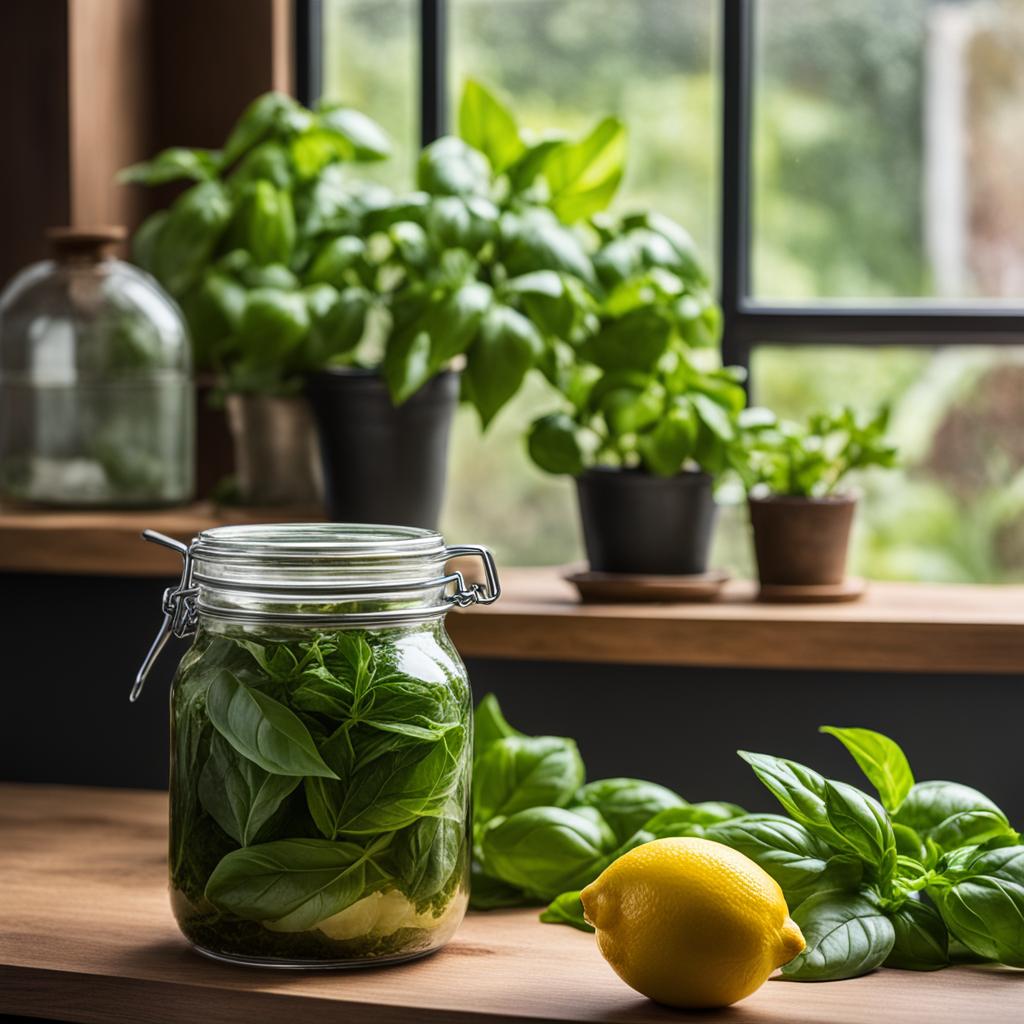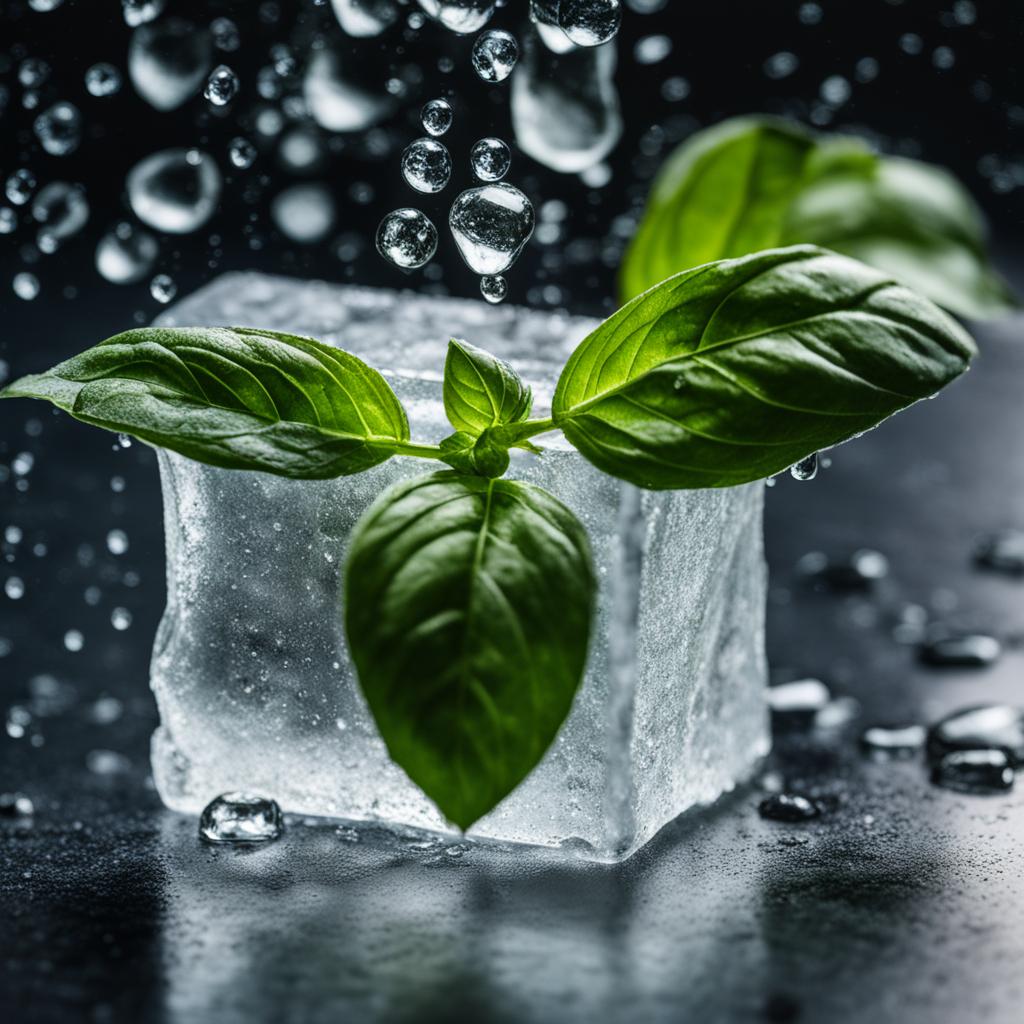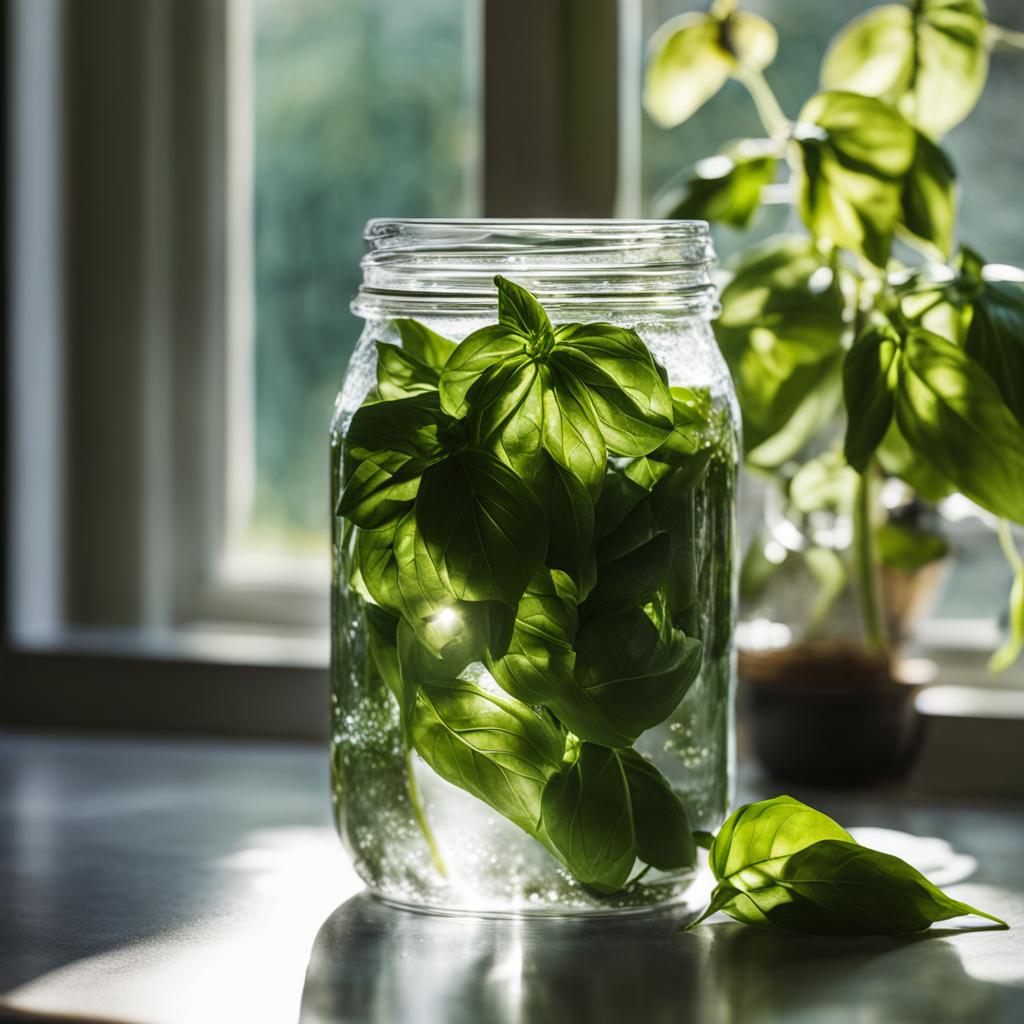Fresh basil is a versatile herb used in Mediterranean cooking. It adds a pop of fresh flavor to dishes like panzanella, tomato basil soup, and grilled pizza. Storing fresh basil can be tricky, but there are methods to keep it fresh and flavorful for up to two weeks.
Key Takeaways:
- Trim the basil stems at a 45-degree angle and place them in a jar of water.
- Cover the jar with a plastic bag, leaving it loosely covered.
- Store the basil at room temperature, avoiding the refrigerator.
- Trim the stems and change the water every few days to maintain freshness.
- Alternatively, freeze basil for long-term storage.
The Best Way to Store Fresh Basil
When it comes to storing fresh basil, it’s important to follow the right methods to ensure maximum flavor and longevity. The best way to store basil is by trimming the stems at a 45-degree angle, similar to a bouquet of flowers. This method helps the basil absorb water and stay fresh for a longer period.
After trimming the stems, fill a jar or glass halfway with water and place the basil stems in the water, making sure no leaves are submerged. The water helps to keep the basil hydrated and vibrant. To protect the leaves, cover the entire jar with a plastic bag, leaving it loosely covered. Storing the basil at room temperature on your kitchen counter is crucial, as refrigeration can cause the leaves to turn dark.
To maintain the freshness of the basil, remember to trim the stems and change the water every few days. This helps to prevent wilting and maintain the flavor of the herb for up to two weeks. By following these simple steps, you can store fresh basil in the best way possible, ensuring that it stays flavorful and ready to enhance your culinary creations.
| Steps | Instructions |
|---|---|
| 1 | Trim the basil stems at a 45-degree angle. |
| 2 | Place the trimmed stems in a jar or glass filled halfway with water. |
| 3 | Cover the jar with a plastic bag, leaving it loosely covered. |
| 4 | Store the basil at room temperature on your kitchen counter. |
| 5 | Trim the stems and change the water every few days. |
Why You Shouldn’t Store Basil in the Refrigerator
Basil is a delicate herb that requires special care when it comes to storage. While refrigeration might seem like a logical choice to keep herbs fresh, it is not the ideal method for storing basil. In fact, storing basil in the refrigerator can actually cause the leaves to turn dark and lose their vibrant flavor.
Basil is highly sensitive to cold temperatures, and the refrigerator creates an environment that is too chilly for this herb. The cold air can damage the delicate cell structure of the basil leaves, resulting in darkened, slimy leaves that are no longer appetizing. By storing basil at room temperature instead, you can maintain its freshness and ensure that it stays vibrant for longer.
When basil leaves are exposed to cold temperatures, they undergo a process called oxidation. This causes the chlorophyll in the leaves to break down, resulting in the dark color. Additionally, the moisture in the refrigerator can cause the leaves to wilt and become slimy. To truly enjoy the full flavor and freshness of basil, it’s best to avoid the refrigerator and explore other storage methods.
Storing Basil at Room Temperature: A Better Alternative
Storing basil at room temperature is the optimal choice to maintain its freshness and flavor. Here’s a simple method to store basil at room temperature:
- Trim the basil stems at a 45-degree angle, similar to a flower bouquet.
- Fill a jar or glass halfway with water, then place the trimmed basil stems in the water.
- Cover the leaves and the entire jar with a loose plastic bag.
- Store the basil jar at room temperature on your kitchen counter.
- Trim the stems and replace the water every few days to keep the basil fresh for up to two weeks.
By following this method, you can ensure that your basil stays vibrant, flavorful, and ready to enhance your culinary creations.
So, remember to avoid the refrigerator when it comes to storing basil. Instead, opt for room temperature storage to maintain the quality and flavor of this versatile herb. Your dishes will thank you!
How to Keep Basil Fresh for Longer
When it comes to storing fresh basil, proper care and attention are essential to keep it fresh and flavorful for as long as possible. By following a few simple steps, you can extend the shelf life of this aromatic herb and ensure it stays vibrant and ready to elevate your dishes.
One key tip is to regularly trim the stems of your basil. This helps to promote water absorption and prevent wilting. By trimming the stems every few days, you can ensure that your basil stays fresh and crisp. Additionally, changing the water in the jar every couple of days helps to maintain its freshness. This prevents the water from becoming stagnant and potentially causing the basil to deteriorate.
Another great way to keep basil fresh is to store it as a bouquet in a jar of water. Treat it like you would fresh flowers – trim the stems, arrange them in a jar of water, and cover the basil loosely with a plastic bag. This method helps to keep the leaves turgid and prevents them from wilting. Plus, it adds a beautiful touch to your kitchen counter!
| Storage Tip | Benefits |
|---|---|
| Trimming stems regularly | Promotes water absorption and prevents wilting |
| Changing water every few days | Maintains freshness by preventing stagnant water |
| Storing basil as a bouquet | Keeps leaves turgid and prevents wilting |
By implementing these simple strategies, you can enjoy the full flavor and aroma of fresh basil for up to two weeks. Whether you’re using it for a Caprese salad or a homemade pesto sauce, keeping your basil fresh is the key to unlocking its true potential in your culinary creations.
The Benefits of Storing Basil as a Flower Bouquet
When it comes to storing fresh basil, one method that offers several benefits is treating it like a flower bouquet and storing it in a jar of water. This method helps to keep the leaves and stems turgid, preventing them from wilting and becoming damaged. The water acts as a hydration source, ensuring that the basil remains fresh and vibrant. Plus, storing basil as a flower bouquet allows for easy access to the basil leaves whenever you need them for cooking or garnishing.

Not only does storing basil in water help to maintain its freshness, but it also adds a touch of elegance to your kitchen. The vibrant green leaves floating in water can make for a visually appealing display. Whether you have a small herb garden or a store-bought bunch of basil, turning it into a flower bouquet adds a charming element to your kitchen counter or dining table.
In addition to the aesthetic benefits, storing basil as a flower bouquet can help extend its shelf life. By keeping the leaves hydrated, this storage method helps to slow down the wilting process and preserve the flavor. It’s a simple yet effective way to ensure that your basil stays fresh and ready to use for a longer period.
Maintaining Freshness and Flavor
By storing basil as a flower bouquet in a jar of water, you can enjoy the benefits of both freshness and convenience. The basil stays vibrant and usable, making it easy to pluck off a few leaves whenever you need them. Whether you’re adding basil to a pasta dish, sprinkling it over a pizza, or making a refreshing caprese salad, having fresh basil readily available will enhance the flavor of your meals.
How to Freeze Basil for Long-Term Storage
If you have an excess amount of fresh basil that you want to preserve for longer periods, freezing it is a great option. Freezing basil helps retain its flavor and allows you to enjoy its vibrant taste in various dishes throughout the year. Here’s a simple method to freeze basil:
- Start by blanching the basil leaves. Bring a pot of water to a boil and carefully place the basil leaves in the boiling water for about 10 seconds. Then, quickly transfer the leaves to an ice bath to cool them down.
- Once the leaves are cool, gently pat them dry with a clean kitchen towel to remove any excess water.
- Next, arrange the basil leaves on a baking sheet in a single layer. Make sure they are not touching each other to prevent them from sticking together.
- Place the baking sheet in the freezer and allow the basil leaves to freeze completely, which usually takes about 12 hours.
- After the leaves are frozen, transfer them into a freezer-safe bag or an airtight container. Label the container with the date to keep track of its freshness.
By following these steps, you can freeze basil leaves and enjoy their fresh flavor whenever you need them. Whether you use the frozen basil in sauces, soups, or other dishes, it will retain its aroma and vibrant green color, adding a burst of freshness to your culinary creations.
Benefits of Freezing Basil
Freezing basil provides several benefits for long-term storage. Not only does it preserve the flavor and color of the herb, but it also allows you to have basil available even when it’s out of season. Here are some key advantages of freezing basil:
- Extended shelf life: Freezing basil allows you to enjoy the herb’s flavor for an extended period, making it a convenient option for those who grow or buy basil in bulk.
- Versatile use: Frozen basil can be used in a variety of dishes, such as pasta sauces, pesto, soups, and stews, adding a burst of fresh aroma and taste to your meals.
- Year-round availability: By freezing basil, you can have access to fresh-tasting basil leaves all year round, even when basil is not in season.
So the next time you find yourself with an abundance of fresh basil, don’t let it go to waste. Instead, freeze it following these simple steps and enjoy the vibrant flavor of basil in your favorite dishes throughout the year.
Tips for Properly Packing Basil for Storage
Properly packing basil for storage is essential to maintain its freshness and flavor for longer periods. Here are some tips to help you pack basil effectively:
Using Damp Paper Towel and Plastic Bag
One method is to wrap the basil in a damp paper towel. This helps to retain moisture and prevents the leaves from drying out. Place the damp paper towel-wrapped basil in a plastic bag, ensuring that the bag is loosely closed. This method creates a humid environment that keeps the basil fresh and vibrant.
Storing Basil in a Glass Jar with Water
If your basil comes with stems, trim the ends and place them in a glass jar with a few inches of water, similar to a bouquet of flowers. Cover the jar with a clear plastic bag, leaving it loosely covered. This method keeps the leaves hydrated and prevents wilting. Remember to change the water daily to maintain freshness.
Using a Container with Dry and Moist Towels
Another option is to place the basil in a container with a dry towel at the bottom and a slightly moist towel at the top. The dry towel absorbs excess moisture, while the moist towel provides the necessary humidity to keep the basil fresh. This method prevents the basil from becoming too wet or too dry.
By following these packing methods, you can prolong the shelf life of basil and ensure that it remains fresh and flavorful for your culinary creations.

The Importance of Room Temperature for Storing Basil
When it comes to storing basil, maintaining the right temperature is crucial for preserving its freshness and flavor. Basil is best stored at room temperature, specifically between 50 to 68 degrees Fahrenheit, with 55 degrees Fahrenheit being the optimal storage temperature. Cold temperatures, such as those in a refrigerator, can damage the delicate cell membranes of basil leaves, causing them to turn black and mushy. By storing basil at room temperature, you can prevent this damage and extend its shelf life.
Another reason why room temperature is ideal for storing basil is because basil thrives in a high humidity environment. A relative humidity level of 90 to 95 percent is perfect for basil. This humidity helps to keep the leaves hydrated and prevents them from drying out or becoming brittle. So, by storing basil at room temperature, you can create the perfect environment for it to stay fresh and vibrant for a longer period.
When storing basil at room temperature, there are a few options to consider. One method is to wrap the basil leaves in a damp paper towel, which helps to maintain moisture levels and prevent wilting. Place the wrapped basil in a loosely sealed plastic bag to provide a balance of humidity and airflow. If your basil has stems, you can also trim the ends and place them in a glass jar filled with a few inches of water, similar to a flower bouquet. Cover the jar with a clear plastic bag to retain moisture and change the water daily to keep the basil fresh.
Table: Room Temperature Storage Tips for Basil
| Storage Method | Steps |
|---|---|
| Wrapping in a Damp Paper Towel | 1. Wrap the basil leaves in a damp paper towel. 2. Place the wrapped basil in a loosely sealed plastic bag. |
| Storing in a Glass Jar with Water | 1. Trim the ends of the basil stems. 2. Place the stems in a glass jar filled with a few inches of water. 3. Cover the jar with a clear plastic bag. |
By understanding the importance of room temperature for storing basil and following proper storage techniques, you can prolong the shelf life of this aromatic herb. Whether you wrap it in a damp paper towel or keep it in a jar of water, the goal is to maintain the right balance of humidity and airflow. With these tips in mind, you can ensure that your basil stays fresh, vibrant, and flavorful for your culinary creations.
Why Not to Completely Seal Basil in a Container
When it comes to storing basil, it is important to avoid completely sealing it in a container. While it may seem like a good idea to keep the basil protected, sealing it can actually create a humid environment, which is unfavorable for its freshness and longevity. Excess moisture from the sealed container can promote the growth of bacteria or mold, leading to spoilage. To ensure that your basil stays fresh and flavorful, it is best to opt for containers or bags that allow for some air circulation.
By allowing air to circulate around the basil, you can maintain the right balance of humidity and moisture. This helps to prevent the basil from becoming too damp, which can cause it to wilt and decay. Instead of sealing the container tightly, choose containers or bags with slight openings or loose closures. This will allow for a controlled exchange of air and help prolong the shelf life of your basil.
In addition to avoiding the complete sealing of basil, it is also important to store it at the proper temperature. Basil is best stored at room temperature, away from direct sunlight and away from sources of heat. This will help maintain its freshness and flavor for a longer period. Remember, the goal is to create an environment that allows the basil to breathe and stay dry, while still providing a controlled level of humidity.
| The Dangers of Sealing Basil Completely in a Container: |
|---|
| Creates a humid environment: Completely sealing basil in a container traps moisture, leading to the growth of bacteria or mold. |
| Promotes spoilage: Excess moisture from a sealed container can cause the basil to wilt and decay. |
| Loss of freshness and flavor: Without proper air circulation, the basil can lose its vibrant freshness and flavor more quickly. |
Freezing Basil for Long-Term Preservation
When it comes to preserving basil for the long term, freezing is an excellent option. Not only does it retain the vibrant color and flavor of the herb, but it also allows for convenient use in various dishes. There are a couple of methods you can try when freezing basil.
Method 1: Making Herb Cubes: One popular method is to make herb cubes. Simply chop the basil leaves and combine them with a neutral oil, such as olive oil, in a blender. Once blended into a paste, transfer the mixture into ice cube trays and freeze. These herb cubes can be easily portioned out for future use in soups, sauces, or stews.
Method 2: Blanching and Freezing: Another method is to blanch the basil leaves before freezing. To do this, briefly immerse the leaves in boiling water for about 10 seconds, then transfer them to an ice bath to cool. Once cooled, pat the leaves dry and arrange them on a baking sheet. Place the baking sheet in the freezer for about 12 hours to freeze the basil leaves individually. After freezing, transfer the leaves to an airtight container or freezer bag.
Regardless of the method you choose, freezing basil is a great way to ensure you have access to the herb year-round. Whether you prefer herb cubes or individually frozen leaves, these preserved basil options will add a burst of fresh flavor to your favorite dishes.

Maximizing the Shelf Life of Basil
When it comes to preserving the freshness and flavor of basil, there are a few key steps you can take to maximize its shelf life. Firstly, it is best to avoid washing the basil until you are ready to use it. Excess moisture can cause the leaves to wilt faster, shortening its longevity. Instead, store the basil in a cool, dry place or in a jar with water, just like a flower bouquet.
Regularly checking the basil for any browning or wilting leaves is also essential. Remove these leaves promptly to prevent the spread of spoilage and to keep the rest of the basil fresh. By maintaining these practices, you can extend the shelf life of your basil and ensure it remains vibrant and flavorful for as long as possible.
Here are some additional tips for maximizing the shelf life of your basil:
- Avoid washing the basil until you are ready to use it.
- Check for any browning or wilting leaves and remove them promptly.
- Store the basil in a cool, dry place or in a jar with water.
- Consider buying hydroponically grown basil, as it tends to last longer and is less prone to bruising.
- Use the basil in a timely manner to make the most of its fresh flavor.
By following these simple yet effective practices, you can enjoy the taste of fresh basil for an extended period, ensuring that your dishes are always bursting with flavor.
Ideal Storage Conditions for Basil
When it comes to storing basil, there are certain conditions that are ideal for maintaining its freshness and flavor. By following these simple storage tips, you can ensure that your basil stays vibrant and usable for a longer period.
Storing Basil at Room Temperature
The first step in proper basil storage is to keep it at room temperature. Unlike many other herbs, basil does not thrive in cold environments, such as the refrigerator. Instead, it prefers temperatures between 50 to 68 degrees Fahrenheit, with 55 degrees Fahrenheit being the optimal storage temperature.
To maintain room temperature conditions, wrap the basil leaves in a damp paper towel. This helps to maintain the right level of moisture without creating a humid environment. Then, place the wrapped basil in a loose plastic bag to provide a balance of humidity and airflow. This method helps prevent the leaves from wilting and becoming damaged.
Storing Basil with Stems
If you have basil with stems, you can treat it like a bouquet of flowers. Trim the stems and place them in a glass jar with a few inches of water. Cover the jar with a clear plastic bag to create a greenhouse-like environment. Remember to change the water daily to keep the basil fresh and vibrant.

Summary
To recap, storing basil at room temperature, wrapped in a damp paper towel and placed in a loose plastic bag, is the ideal way to maintain its freshness. If you have basil with stems, treat it like a bouquet of flowers by placing the trimmed ends in a glass jar with water and covering it with a clear plastic bag. By following these storage recommendations, you can enjoy the rich flavor of fresh basil for longer periods of time.
Long-Term Storage Option: Freezing Basil
If you have an abundance of fresh basil and want to preserve it for longer periods, freezing basil is a great option. Freezing helps retain the flavor and aroma of basil, making it convenient for use in various dishes throughout the year.
To freeze basil, start by blanching the basil leaves. Blanching involves briefly immersing the leaves in boiling water for about 10 seconds, then quickly transferring them to an ice bath to cool. This process helps preserve the bright green color and flavor of the basil.
Once the basil leaves are blanched and cooled, squeeze out any excess water and arrange the leaves on a baking sheet in a single layer. Place the baking sheet in the freezer and allow the basil to freeze for about 12 hours. Once frozen, transfer the basil leaves to an airtight container or freezer-safe bag for long-term storage.
| Step | Description |
|---|---|
| 1 | Blanch basil leaves in boiling water for 10 seconds. |
| 2 | Transfer blanched leaves to an ice bath to cool. |
| 3 | Squeeze out excess water from the leaves. |
| 4 | Arrange leaves on a baking sheet in a single layer. |
| 5 | Freeze leaves for about 12 hours. |
| 6 | Transfer frozen leaves to an airtight container or freezer-safe bag. |
When using the frozen basil, you can easily remove individual leaves as needed, eliminating the need to thaw the entire batch. Frozen basil works well in cooked dishes such as soups, stews, sauces, or even pesto. However, it may lose some of its texture and become slightly limp after thawing, which is why it’s best suited for cooked preparations.
Pro Tip:
Label your freezer container or bag with the date to ensure you use the basil within a reasonable timeframe. Frozen basil can remain flavorful for about 6 to 12 months, although it’s ideal to use it within the first 6 months for the best taste.
By freezing basil, you can conveniently store this fragrant herb for long periods, enabling you to enjoy its fresh taste and aroma even when it’s not in season. Whether you’re making a hearty winter stew or a refreshing summer pasta dish, having frozen basil on hand ensures you’ll always have a burst of flavor at your fingertips.
Extending the Shelf Life of Basil
When it comes to maximizing the shelf life of basil and keeping it fresh for as long as possible, there are a few key tips to keep in mind. Avoid washing the leaves until you are ready to use them, as the additional moisture can cause the basil to wilt faster. Instead, gently wipe the leaves with a damp cloth to remove any dirt or debris. By avoiding washing until the last minute, you can help extend the freshness of the basil.
Regularly checking the basil for any signs of browning or wilting is also crucial. If you notice any leaves that are starting to turn brown or wilted, promptly remove them to prevent the spread of spoilage. By regularly inspecting the basil and removing any damaged leaves, you can help maintain the overall freshness and quality of the herb.
Additionally, it’s important to store basil in a cool, dry place away from direct sunlight. Exposure to excessive heat or light can accelerate the wilting and spoilage of basil. To further extend the shelf life, consider wrapping the basil in a damp paper towel before placing it in a loose plastic bag. This will help maintain the right balance of humidity and moisture to keep the leaves fresh and vibrant.
Conclusion
In conclusion, storing fresh basil correctly is essential to maintain its flavor and prolong its shelf life. By following these storage tips, you can enjoy the vibrant taste of fresh basil for longer periods of time.
Firstly, it is best to store basil at room temperature rather than in the refrigerator. Cold temperatures can cause the leaves to turn dark and slimy, reducing their freshness. Instead, trim the basil stems at a 45-degree angle and place them in a jar of water, similar to a bouquet of flowers. Cover the jar loosely with a plastic bag and store it on your kitchen counter.
If you have an excess amount of basil, freezing it is a great option for long-term storage. Blanch the basil leaves briefly in boiling water, then cool them in an ice bath to preserve their color and flavor. Freeze the leaves on a baking sheet and transfer them to an airtight container. This way, you can enjoy the taste of basil year-round in various dishes.
Remember, avoid washing the basil until you’re ready to use it and regularly check for any browning or wilted leaves. By applying these storage techniques, you can keep your fresh basil flavorful and extend its shelf life.
FAQ
How should I store fresh basil to keep it flavorful?
Trim the stems at a 45-degree angle and place them in a jar of water. Cover the jar with a plastic bag and store at room temperature.
Can I store basil in the refrigerator?
It’s best to avoid storing basil in the refrigerator, as it can cause the leaves to turn dark and slimy.
How can I keep basil fresh for longer?
Trim the stems regularly and change the water in the jar every few days to keep basil fresh for up to two weeks.
What are the benefits of storing basil as a flower bouquet?
Storing basil in water like a bouquet keeps the leaves and stems turgid, preventing wilting and maintaining freshness.
How can I freeze basil for long-term storage?
Blanch the basil leaves, then freeze them on a baking sheet before transferring to a freezer-safe bag or making herb cubes.
What are some tips for properly packing basil for storage?
Place basil in a container with a damp paper towel or in a glass jar with water to maintain the right moisture level.
What is the ideal storage condition for basil?
Basil is best stored at room temperature, between 50 to 68 degrees Fahrenheit, with 55 degrees Fahrenheit being optimal.
Why shouldn’t I completely seal basil in a container?
Completely sealing basil can create a humid environment, promoting the growth of bacteria or mold.
How can I maximize the shelf life of basil?
Avoid washing the leaves until you’re ready to use them and regularly check for any browning or wilting leaves to remove.
What are the best ways to store basil?
Wrap basil in a damp paper towel and place it in a loose plastic bag or trim the stems and put them in a jar of water.
How can I extend the shelf life of basil?
Avoid washing basil until ready to use, remove any browning or wilted leaves, and consider buying hydroponically grown basil.
What are the ideal storage conditions for basil?
Store basil at room temperature in a loose plastic bag or in a jar of water covered with a plastic bag.
Can I freeze basil for long-term storage?
Yes, blanch the basil leaves and freeze them individually or combine them with oil to make herb cubes.
How can I store basil to maintain its freshness?
Wrap basil in a damp paper towel and place it in a loose plastic bag or trim the stems and put them in water like a flower bouquet.
Why is it important to avoid washing basil until ready to use?
Washing basil adds extra moisture and can cause it to wilt faster, reducing its longevity.
What can I do to extend the shelf life of basil?
Remove any browning or wilted leaves and keep an eye out for signs of spoilage.
Source Links
- https://www.bonappetit.com/test-kitchen/inside-our-kitchen/article/how-to-store-basil
- https://www.marthastewart.com/how-to-store-basil-7563482
- https://www.themediterraneandish.com/how-to-store-fresh-basil/
Related Recipes:
 How to Store Parsley? (Perfect Every Time!)
How to Store Parsley? (Perfect Every Time!)
 How to Make Basil Oil? (Perfect Step-by-Step Guide)
How to Make Basil Oil? (Perfect Step-by-Step Guide)
 How to Store Fish to Ensure Freshness
How to Store Fish to Ensure Freshness
 How to Store Baked Goods to Keep Them Fresh
How to Store Baked Goods to Keep Them Fresh
 How to Store Fresh Herbs to Maximize Freshness
How to Store Fresh Herbs to Maximize Freshness
 How to Store Carrots? (Perfect Every Time!)
How to Store Carrots? (Perfect Every Time!)
 How to Store Asparagus to Maintain Freshness
How to Store Asparagus to Maintain Freshness
 How to Store Cucumbers to Keep Them Crisp
How to Store Cucumbers to Keep Them Crisp








